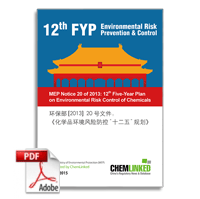
English version available!
12th Five-Year Plan on Environmental Risk Control of Chemicals
The 12th Five Year Plan of Chemical Environmental Risk Prevention and Control was introduced on 20 Feb, 2013.
This is China’s first ever five year plan targeting the environmental management of chemicals. Greenpeace perceives two key features of the plan:
58 kinds of chemicals are for the first time listed into the priority risk prevention and control “blacklist”, which includes DEHP, endocrine disruptors, NP, etc.
Textile industry, as a downstream consumer industry, is classified as one of the 7 major risk prevention and control industries. They include petroleum refining, coking and nuclear fuel processing industry, chemical materials and products manufacturing industry, pharmaceutical manufacturing industry, chemical fiber manufacturing industry, nonferrous metal smelting and calendaring industry, textile industry and novel coal chemical industry.
Highlights of the Plan:
What’s phased out abroad is mass produced in China
Greenpeace holds that the birth of the first Chinese chemical blacklist, highlighting the risk of major chemicals including DEHP and endocrine disruptors, will fill the domestic chemical environmental management gap and prevent the international transfer of chemical pollutants into China. The Plan indicates that some toxic chemicals phased out or restricted by the developed world are still being mass produced and used in China and that some highly risky chemical production capabilities are being transferred to China. Take NP, an endocrine disruptor, as an example. Because it faced the “phase-out” ban in the major developed countries, its output decreased from 50000 tons in 1998 to 36000 tons in 2003 worldwide. Meanwhile, the output of the Chinese NP almost doubled. In 2011, China produced 48000 tons of NPs and imported another 28000 tons. Similarly, the output of DEHP decreased dramatically from 250000 tons in 1992 to around 50000 tons in 2004 because of the deadline of its being phased out in EU was approaching. However, in China, DOPs including DEHP continues to grow. In Jan-Apr 2012 alone, its output stood at 223000 tons, registering a year-on-year growth of 7.87%.
Huge Environmental Risks and Threat to Drinking Water
The accumulated risk chemical category of the 58 kinds of priority risk prevention and control chemicals has health and environmental damages. The Plan indicates that “In recent years, many chemicals have been detected in some rivers, lakes and offshore waters, wildlife and human bodies and that some regions have seen their persistent organic pollutants and endocrine disruptors above the international level”. For instance, in the waters from Songhua River to Haerbing, 13 kinds of endocrine disruptors including DEHP and NP were detected 100%. The detection rates of several DEHP substances in the source water of 10 town water plants in Zhejiang were also very high, with some the detection rates reaching 100%. Such substances were also found in the underground water of Wuhan. The first inclusion of these persistent and accumulated pollutants into this Priority Risk Prevention and Control List shows that controlling and reducing their release have been put on the agenda. Substances including DFHP and endocrine disruptors on the list are industrial chemicals still being mass produced. Thus this list will send out a strong signal to the market, promoting the gradual reduction and elimination of relevant products and encouraging the exploration of alternatives.
Downstream Industries Enters the Regulation Vision
The inclusion of textile industry into the priority risk prevention and control industries symbolizes that China’s chemical management is no longer simply about upstream chemical production industries and that downstream consumer industries become the new target for regulation. The UN statistics shows that China is the largest textile chemical consumer in the world. Each year, over a quarter of textile chemicals in the world are consumed by Chinese textile industry. Some of them are hazardous. The past Greenpeace textile industry investigations indicate that waste water by the Chinese textile industry contains NP, PFCs and many other hazardous substances. Thus the inclusion of textile industry into the priority risk prevention and control industries will help reduce the environmental impact of the downstream chemical industry chain (namely use and release).
The output value of the Chinese chemical industry in 2010 ranked the first in the world. The number of chemicals used and produced that are recorded reaches over 40000. But the environmental regulation of chemicals in China remains relatively backward. The number of chemicals listed into the Hazardous Chemical List is only above 3000, and only about 10% of the existing chemical in China have been evaluated for environmental and health hazards. Chinese chemical management has been in the state of “a dwarf managing a giant” since long. Therefore, the adoption of the Plan will, to some degree, change the situation.
Media Contacts:
Yixiu Wu, Toxics Campaigner, Greenpeace East Asia
Phone: 86 10-6554 6931 Ext.177
Mobile: 86-158 1046 0835 wu.yixiu@greenpeace.org
Guan Yuanyuan, Media Officer, Greenpeace East Asia
Phone: 86 10-6554 6931 Ext.123
Mobile: 86-186 1198 0736 guan.yuanyuan@greenpeace.org
















